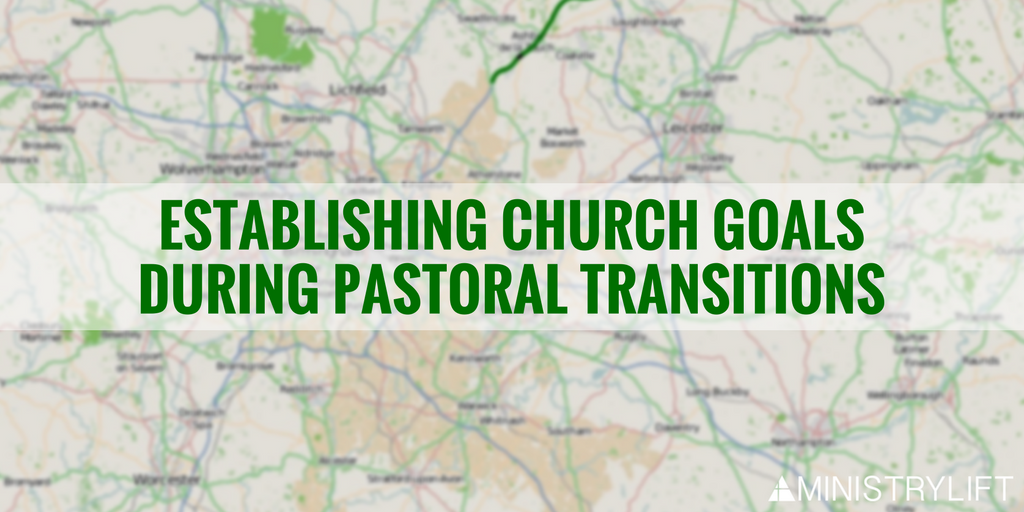Establishing Church Goals During Pastoral Transitions
 Times of pastoral transition are windows of opportunity for a congregation to experience turning points towards health and renewed ministry. Welcoming a new senior pastor into a healthy, functional, and spiritually-renewed church community is a goal worth pursuing!
Times of pastoral transition are windows of opportunity for a congregation to experience turning points towards health and renewed ministry. Welcoming a new senior pastor into a healthy, functional, and spiritually-renewed church community is a goal worth pursuing!
There are two approaches to pastoral transition―a more traditional approach or an intentional-transitional approach. There was a day when a "hold-the-fort-until-the-next-pastor-arrives" mindset worked, but this is less effective today.
The Intentional-Transitional Approach
The intentional-transitional approach focuses on seeing the time between pastors as a season of opportunity, and a time to facilitate meaningful and sustainable change. In this model, the transitional leader is a trained specialist and prepares the congregation to eventually do their search from a posture of health, prayer, and readiness.
The Five Benefits to the Intentional-Transitional Model
Why is it worth taking the time and trouble to engage in a well-planned transition? Let me give you with five of the benefits:
1. During transition, you can create an atmosphere that fosters positive change and healthy adjustment.
2. During transition, you have the opportunity to bring in outside specialists who are equipped to facilitate change―a luxury you often can’t afford during seasons of regular ministry.
3. During transition, the focus on overall church health sets up the search process to be conducted from a place of strength, clear identity, and vision.
4. The intentional-transitional model allows a congregation to work systematically through a process that recognizes key milestones and gives opportunity to involve new people.
5. The transitional model gives the opportunity to deal with unwanted sacred cows and elephants too difficult to tackle during seasons of normal ministry.
Eight Transitional Goals
Below are descriptions of the eight transitional goals you seek to achieve during the transitional process. There is flexibility in how to achieve these goals, but the principles are fixed.
1. Facilitating Closure
Closure involves dealing with the past so as not to hinder what God is wanting to do in the future. A transitional leader serves as counselor and skilled listener―helping individuals relate to and deal with their past so it does not negatively impact God’s plan for the future.
2. Facilitating Preaching
Preaching during transition needs to be more than old sermons re-preached. The preaching needs to be freshly-minted messages from God that ring true in the hearts and lives of the people for where they are during their transition.
Loving congregational care is essential during a season of transition. The transitional leader models and practices pastoral care but also equips and ensures that other people are involved in this activity.
4. Facilitating Administration
During times of transition, regular ministry life needs to be organized in such a way to ensure continuity and consistency. The transitional leader partners with other gifted leaders and congregational members to ensure care takes place.
5. Facilitating Relationship Renewal
Relationship renewal refers to the relationship church members have with God, one another, and with those outside the body of Christ. Applying the agape principle is essential for this to take place.
6. Facilitating Vision Clarity
The time during a pastoral transition is an opportunity to revisit the vision to determine its relevance and whether it needs reviewing, redoing, or renewing.
7. Facilitating Organizational Health
Facilitating organizational health examines the theology, practice, governance, and traditions of congregational structure. It also speaks to the way a congregation is managed and inter-related to each other through systems and structures.
8. Facilitating the Search Process
An active search takes place after a congregation achieves a certain level of health and unity. If started too early, it distracts from other necessary work best done without the search going on.
Final Thoughts
For more information and an in-depth look at this process, pick up a copy of Between Pastors: Seizing the Opportunity written by Alan Simpson and myself. You can find it on amazon.ca as a paperback or ebook. You can find more resources on our website: www.tlm.outreach.ca.
Cam Taylor is Director of Transitional Leadership Ministries and will be leading a three-day training conference in BC on May 10-12, 2017 and in Ontario on May 29-31 (click here for information on the training).
